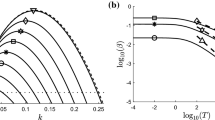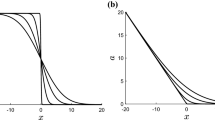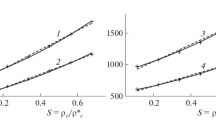Abstract
The stability of several density profiles constructed from a linear combination of step functions in a vertically orientated two-dimensional porous medium are considered. A quasi-steady-state approximation is made so that the initial stability of the system can be approximated. Using a similar approach to that of Tan and Homsy (Phys Fluids 29:3549–3556, 1986) a dispersion equation for each density profile is obtained analytically at time zero. Neutral stability curves are then obtained to allow the regions of the parameter space to be divided into stable and unstable regions.








Similar content being viewed by others
References
Lord Rayleigh (1883) Investigation of the character of the equilibrium of an incompressible heavy fluid of variable density. Proc Lond Math Soc 14:170–177
Taylor GI (1950) The instability of liquid surfaces when accelerated in a direction perpendicular to their planes. Proc R Soc Lond A 201:192–196
Sharp DH (1984) An overview of Rayleigh–Taylor instability. Phys D 12:3–18
Cabot WH, Cook AW (2006) Reynolds number effects on Rayleigh–Taylor instability with possible implications for type-Ia supernovae. Nat Phys 2:562–568
Conrad CP, Molnar P (1997) The growth of Rayleigh–Taylor-type instabilities in the lithosphere for various rheological and density structures. Geophys J Int 129:95–112
Citri O, Kagan ML, Kosloff R, Avnir D (1990) The evolution of chemically induced unstable density gradients near horizontal reactive interfaces. Langmuir 6:559–564
Stommel H, Arons AB, Blanchard D (1956) An oceanographic curiosity: the perpetual salt fountain. Deep-Sea Res 3:152–152
Stern ME (1960) The salt-fountain and thermohaline convection. Tellus 12:172–177
Huppert HE, Mannis PC (1973) Limiting conditions for salt-fingering at an interface. Deep-Sea Res 20:315–323
Trevelyan PMJ, Almarcha C, De Wit A (2011) Buoyancy-driven instabilities of miscible two-layer stratifications in porous media and Hele–Shaw cells. J Fluid Mech 670:38–65
D’Hernoncourt J, Zebib A, De Wit A (2007) On the classification of buoyancy-driven chemo-hydrodynamic instabilities of chemical fronts. Chaos 17:013109
Saffman PG, Taylor G (1958) The penetration of a fluid into a medium or Hele–Shaw cell containing a more viscous liquid. Proc Soc Lond A 245:312–329
Homsy GM (1987) Viscous fingering in porous media. Ann Rev Fluid Mech 19:271–311
Pritchard D (2009) The linear stability of double-diffusive miscible rectilinear displacements in a Hele–Shaw cell. Eur J Mech B 28:564–577
Mishra M, Trevelyan PMJ, Almarcha C, De Wit A (2010) Influence of double diffusive effects on miscible viscous fingering. Phys Rev Lett 105:204501
Hickernell FJ, Yortsos YC (1986) Linear stability of miscible displacement processes in porous media in the absence of dispersion. Stud Appl Math 74:93–115
Manickam O, Homsy GM (1993) Stability of miscible displacements in porous media with non-monotonic viscosity profiles. Phys Fluids A 5:1356–1367
Manickam O, Homsy GM (1994) Simulation of viscous fingering in miscible displacements with non-monotonic viscosity profiles. Phys Fluids 9:95–107
Tan CT, Homsy GM (1986) Stability of miscible displacements in porous media: rectilinear flow. Phys Fluids 29:3549–3556
Daripa P (2008) Studies on stability in three-layer Hele–Shaw flows. Phys Fluids 20:112101
Ben Y, Demekhin EA, Chang HC (2002) A spectral theory for small amplitude miscible fingering. Phys Fluids 14:999–1010
Kim MC (2012) Linear stability analysis on the onset of the viscous fingering of a slice in a porous medium. Adv Water Res 35:1–9
Riaz A, Hesse M, Tchelepi HA, Orr FM (2006) Onset of convection in a gravitationally unstable diffusive boundary layer in porous media. J Fluid Mech 548:87–111
Nield DA, Bejan A (2006) Convection in porous media. Springer, New York
Martin J, Rakotomalala N, Salin D (2002) Gravitational instability of miscible fluids in a Hele–Shaw cell. Phys Fluids 14:902–905
Cross M, Hohenberg PC (1993) Pattern-formation outside of equilibrium. Rev Mod Phys 65:851–1112
MAPLE 15 (2011) Waterloo Maple Inc., Waterloo Ontario, Canada
Acknowledgments
PMJT would like to thank Prof. Anne De Wit for numerous fruitful discussions. Both authors would like to thank all three anonymous referees for their constructive comments and suggestions, which helped to improve this paper.
Author information
Authors and Affiliations
Corresponding author
Appendix
Appendix
The dispersion equation for two separated layers is given by
where \(P_{nm}=R_1 k(s+(-1)^n k)+(-1)^m 2\sigma s\) and \(Q_{nm}=R_2 k(s+(-1)^n k)+(-1)^m 2\sigma s\) such that \(n\) and \(m\) are either 0 or 1.
The cut-off wavenumber for two separated layers satisfies the following equation:
Rights and permissions
About this article
Cite this article
Gandhi, J., Trevelyan, P.M.J. Onset conditions for a Rayleigh–Taylor instability with step function density profiles. J Eng Math 86, 31–48 (2014). https://doi.org/10.1007/s10665-013-9649-2
Received:
Accepted:
Published:
Issue Date:
DOI: https://doi.org/10.1007/s10665-013-9649-2




